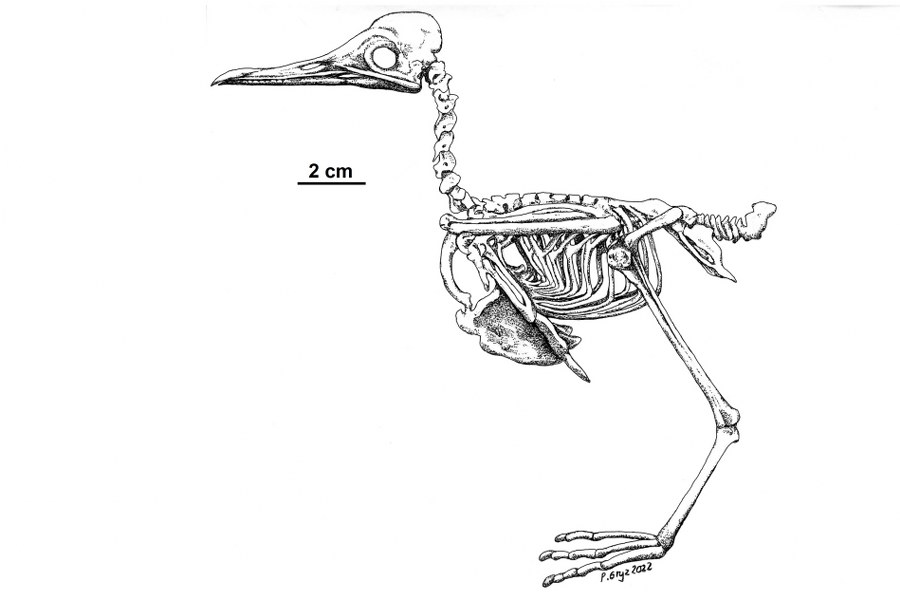Rupelornis definitus (van Beneden, 1871)
Sugerowana cytacja: Gryz, P. 2022. Rupelornis definitus (van Beneden, 1871) . Ikonoteka (http://ikonoteka.paleo.pan.pl/xwiki/bin/view/Species/Rupelornis+definitus)
Diagnoza Straighter and more craniocaudally curved femur and larger size than the Rupellornis brodkorbi. Porównanie Rupelornis babaheydariensis differs from R. definitus some morphological features, eg. proportionally narrower distal tarsometatarsus. Rupelornis brodkorbi is smaller and Rupelornis harmathi is larger. Autekologia Less adapted to gliding than most extant procellariiforms and more likely employed flap-gliding, as do extant Oceanitidae. The feet may not only have served as a brake for rapid stops when the bird caught sight of prey near the water surface but, immersed into the water, they may have also facilitated a stationary position of the flying bird at open sea. Występowanie geograficzne Germany (Espenhain, Frauenweiler), Belgium (Steendorp, Niel-Boom, Rumst ), Poland (Pogorzany) Zasięg czasowy Early Oligocene, Rupelian Materiały muzealne Materials from Germany (MB.Av., SMF), Belgium (BSP, IRSNB) and Poland (ZPAL). Literatura van Beneden, P.J. 1871. Les oiseaux de l’argile rupélienne. Bulletin de l’Académie Royale des Sciences, Lettres et Beaux- Arts de Belgique, série 2 32: 256–261. Cheneval, J. 1996. Tertiary avian localities of Belgium. In: Mlíkovský J., ed. Tertiary avian localities of Europe. Acta Universitatis Carolinae, Geologica, Vol. 39. Praha: Univerzita Karlova, 535–540. Elżanowski, A., Bieńkowska-Wasiluk, M., Chodyń, R. and Bogdanowicz, W. 2012. Anatomy of the coracoid and diversity of the Procellariiformes (Aves) in the Oligocene of Europe. Palaeontology 55: 1199–1221 Fischer, K. 1983. Möwenreste (Laridae, Charadriiformes, Aves) aus dem mitteloligozänen Phosphoritknollenhorizont des Weißelsterbeckens bei Leipzig (DDR). Mitteilungen aus dem Zoologischen Museum in Berlin 59, Supplement: Annalen für Ornithologie 7: 151–155. Fischer, K. 1985. Ein albatrosartiger Vogel (Diomedeoides minimus nov. gen., nov. sp., Diomedeoididae nov. fam., Procellariiformes) aus dem Mitteloligozän bei Leipzig (DDR). Mitteilungen aus dem Zoologischen Museum in Berlin 61, Supplement: Annalen für Ornithologie 9: 113–118. Fischer K. 1997. Neue Vogelfunde aus dem mittleren Oligozän des Weißelsterbeckens bei Leipzig (Sachsen). Mauritiana 16: 271–288. Mayr, G. 2009. Notes on the osteology and phylogenetic affinities of the Oligocene Diomedeoididae (Aves, Procellariiformes), Fossil Records 12: 133–140. May,r G. 2022. Paleogene fossil birds. Second edition. Heidelberg: Springer. Mayr, G. and Smith, T. 2012a. Phylogenetic affinities and taxonomy of the Oligocene Diomedeoididae, and the basal divergences amongst extant procellariiform birds. Zoological Journal Linnean Society 166: 854–875. Mayr, G., Peters, D.S. and Rietschel, S. 2002. Petrel-like birds with a peculiar foot morphology from the Oligocene of Germany and Belgium (Aves: Procellariiformes). Journal of Vertebrate Paleontology 22: 667–676. de Pietri, V. L., Berger, J.-P., Pirkenseer, C., Scherler, L. and Mayr, G. 2010. New skeleton from the early Oligocene of Germany indicates a stem-group position of diomedeoidid birds. Acta Palaeontologica Polonica 55 (1): 23-34. |
|

